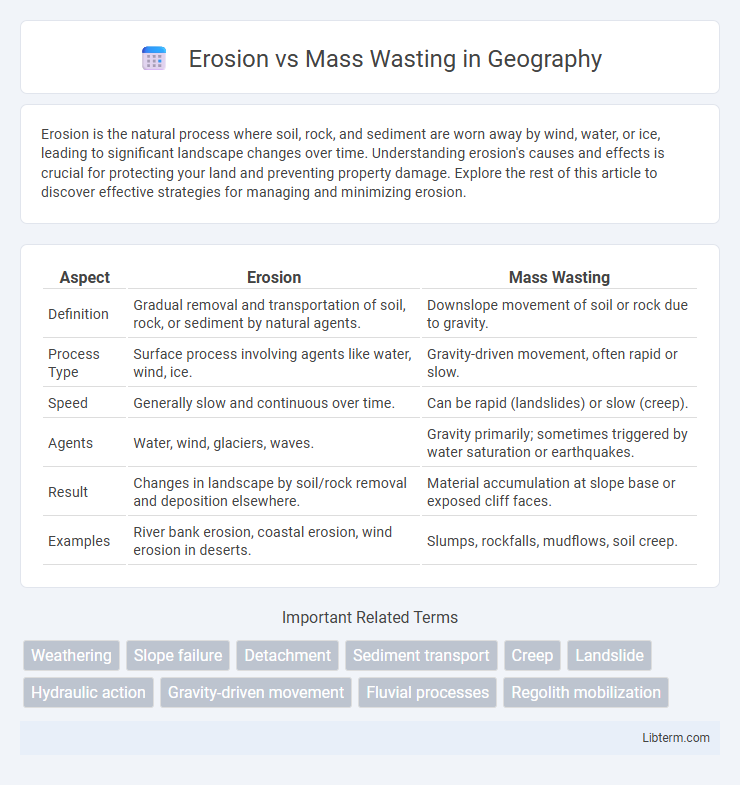Erosion is the natural process where soil, rock, and sediment are worn away by wind, water, or ice, leading to significant landscape changes over time. Understanding erosion's causes and effects is crucial for protecting your land and preventing property damage. Explore the rest of this article to discover effective strategies for managing and minimizing erosion.
Table of Comparison
| Aspect | Erosion | Mass Wasting |
|---|---|---|
| Definition | Gradual removal and transportation of soil, rock, or sediment by natural agents. | Downslope movement of soil or rock due to gravity. |
| Process Type | Surface process involving agents like water, wind, ice. | Gravity-driven movement, often rapid or slow. |
| Speed | Generally slow and continuous over time. | Can be rapid (landslides) or slow (creep). |
| Agents | Water, wind, glaciers, waves. | Gravity primarily; sometimes triggered by water saturation or earthquakes. |
| Result | Changes in landscape by soil/rock removal and deposition elsewhere. | Material accumulation at slope base or exposed cliff faces. |
| Examples | River bank erosion, coastal erosion, wind erosion in deserts. | Slumps, rockfalls, mudflows, soil creep. |
Introduction to Erosion and Mass Wasting
Erosion involves the gradual removal of soil, rock, or sediment from one location by natural forces like water, wind, or ice, reshaping landscapes over time. Mass wasting refers to the downslope movement of soil and rock under the influence of gravity, including processes such as landslides, mudflows, and rockfalls. Both phenomena significantly impact geological formations, but erosion is driven primarily by external agents while mass wasting results from gravitational instability.
Defining Erosion: Causes and Processes
Erosion is the natural process that involves the wearing away and removal of soil, rock, or sediment from the Earth's surface by agents such as water, wind, ice, or gravity. Key causes include rainfall runoff, river flow, coastal wave action, and glacial movement, which transport particles downstream or downslope. Erosion processes encompass hydraulic action, abrasion, and dissolution, each contributing to landscape changes and sediment redistribution.
Understanding Mass Wasting: Types and Triggers
Mass wasting refers to the downhill movement of soil, rock, and debris due to gravity, categorized into types such as landslides, rockfalls, mudflows, and creep. Triggers include heavy rainfall, earthquakes, volcanic activity, and human disturbances like deforestation or construction. Understanding these factors is crucial for assessing risks and implementing effective slope stabilization techniques.
Key Differences Between Erosion and Mass Wasting
Erosion involves the gradual removal and transportation of soil or rock by natural agents such as water, wind, or ice, affecting large geographic areas over extended periods. Mass wasting refers to the rapid downslope movement of soil and rock due to gravity, often causing sudden landslides or debris flows in localized regions. Unlike erosion, which primarily relies on external forces to move materials progressively, mass wasting is driven chiefly by gravitational instability without the need for a transporting medium.
The Role of Water in Erosion and Mass Wasting
Water plays a crucial role in both erosion and mass wasting by acting as a primary agent that transports sediments and destabilizes slopes. In erosion, water runoff removes soil and rock particles, especially during heavy rainfall or melting snow, contributing to landform changes. In mass wasting, water increases pore water pressure within soil and rock layers, reducing cohesion and triggering landslides, mudflows, and debris flows.
Human Impacts on Erosion vs Mass Wasting
Human activities like deforestation, urbanization, and agriculture accelerate erosion by removing vegetation that stabilizes soil, increasing sediment runoff into waterways. Construction, mining, and improper land use destabilize slopes, triggering mass wasting events such as landslides and rockfalls, which pose risks to infrastructure and human safety. Soil conservation practices and effective land management are critical in mitigating human-induced erosion and mass wasting hazards.
Effects on Landscapes: Erosion and Mass Wasting Compared
Erosion gradually shapes landscapes by transporting soil and rock particles through wind, water, and ice, resulting in smoother landforms like valleys and deltas. Mass wasting involves rapid or slow downslope movement of large volumes of earth material, causing sudden changes such as landslides, rockfalls, and debris flows that can reshape hillsides and create scarps. Both processes alter terrain but erosion typically produces gradual transformation, whereas mass wasting leads to abrupt and often more dramatic topographical changes.
Prevention and Management Strategies
Erosion prevention relies on vegetation cover, terracing, and controlled water flow to minimize soil loss and sediment displacement. Mass wasting management involves slope stabilization techniques such as retaining walls, rock bolts, drainage control, and reforestation to reduce landslide risks. Both processes benefit from continuous monitoring and land-use planning to mitigate environmental damage and enhance terrain stability.
Real-World Examples and Case Studies
Erosion and mass wasting significantly impact landscapes worldwide, with erosion exemplified by the Mississippi River Delta's gradual land loss due to sediment displacement by water flow. The 2018 Montecito landslides in California demonstrate mass wasting, where rapid downhill movement of earth and debris caused widespread destruction after heavy rains. Both processes illustrate critical geological hazards, with erosion reshaping coasts and riverbanks, while mass wasting triggers sudden slope failures in mountainous regions.
Conclusion: Importance of Understanding Surface Processes
Understanding surface processes like erosion and mass wasting is crucial for effective land management and hazard mitigation. Erosion involves gradual material removal by water, wind, or ice, while mass wasting refers to sudden downslope movement of soil and rock due to gravity. Recognizing these dynamics helps predict landscape changes, prevent infrastructure damage, and protect ecosystems.
Erosion Infographic

 libterm.com
libterm.com